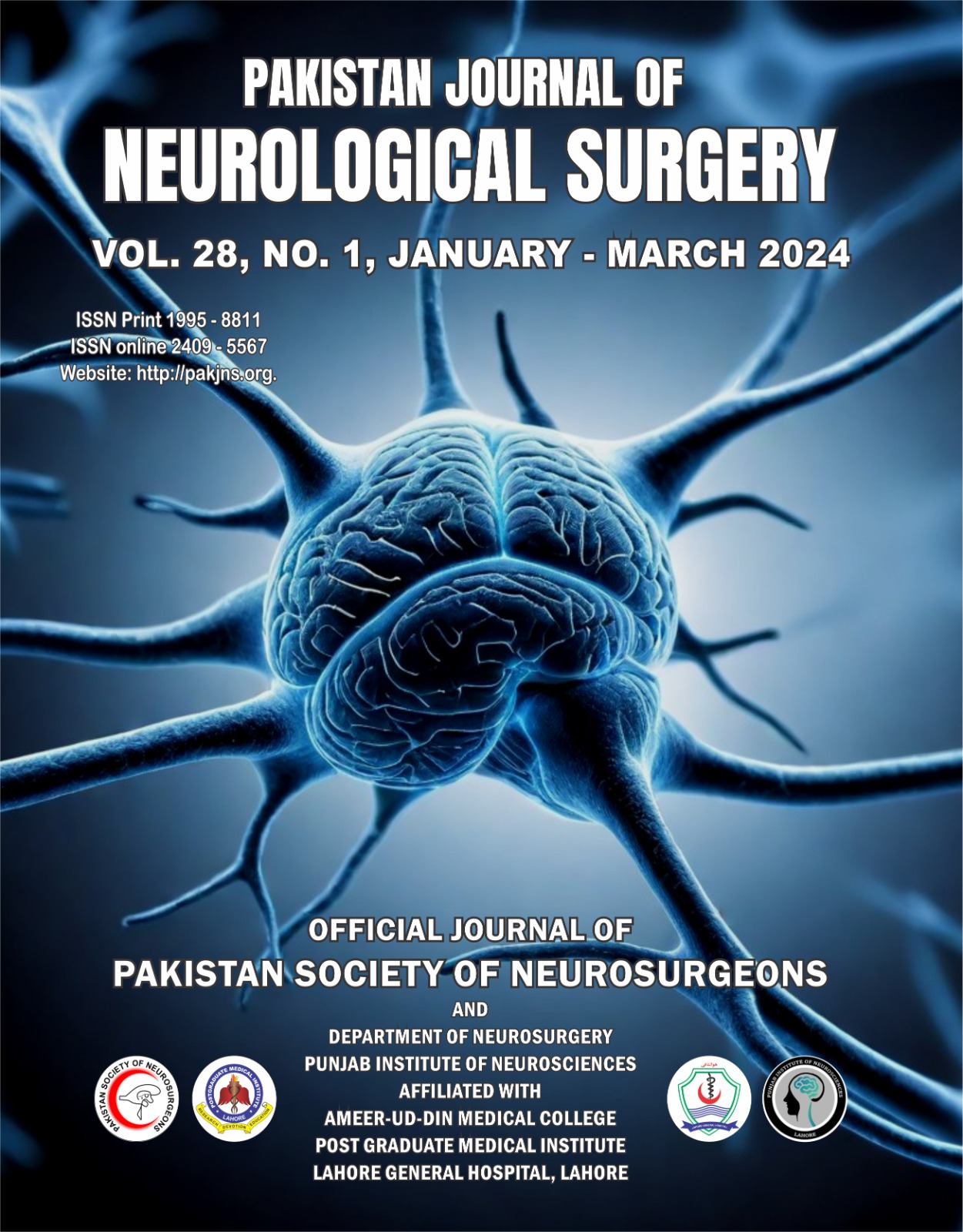The Prevalence of Post-operative Complications Following Meningomyelocele Repair
DOI:
https://doi.org/10.36552/pjns.v28i1.956Keywords:
Post-Operative Complications, Wound Infection, CSF LeakAbstract
Objective: To assess the incidence of post-operative complications after meningomyelocele repair in patients presenting with Meningocele.
Materials & Methods: All the patients presenting with meningocele and myelomeningocele, age between 1 day to 5 years, both genders and patients with ASA grade I and II were included. All the baseline /routine hospital investigation was done, the lesions were assessed for age, size duration of symptoms, and location and were checked for cerebrospinal fluid leaks. The presence of associated abnormalities was evaluated. The patients were given antibiotics as per protocol before and after surgery to prevent infection. All patients were observed closely in the post-operative period for development and timely management of any complications.
Results: Among 145 children, 9% of children had defects in the cranio cervical and 91% of children had defects in the lumbosacral. 15% children had myelomeningocele size ?3 cm while 85% of children had myelomeningocele size >3 cm. 83% of children were male and 17% of children were female. 18% of children had wound infection, 6% of children had wound dehiscence and 26% of children had CSF Leak. Stratification of postoperative complications concerning age, gender, location of NTD (cranio cervical/lumbo sacral), size (? 3 cm & > 3 cm), duration of symptoms (? 1 month & 1 month), malnourished (yes/no) showed the insignificant differences.
Conclusion: The frequency of post-operative complications i.e. wound infection was 18%, wound dehiscence was 6% and CSF Leak was 26% after meningomyelocele repair in patients presenting with Meningocele.
References
Tomatir, B. Kiray Vural, I. Acikbas abd B. Akdag. Registries of cases with neural tube defects in Denizli, Turkey, 2004-2010. Genet. Mol. Res. 2014;13(4):8537-8543.
Zaputovic S, Stanojevic M, Honemeyer U, Turudic T, Kurjak A. Surgically Correctable Fetal Anomalies: Ultrasound Diagnosis and Management. Donald School J Ultrasound Obstet Gynecol 2012;6(3):237-256.
Jung-Hwan Shim, Na-Hyun Hwang, Eul-Sik Yoon, Eun-Sang Dhong, Deok-Woo Kim, Sang-Dae Kim. Closure of Myelomeningocele Defects Using a Limberg Flap or Direct Repair. Arch Plast Surg 2016;43:26-31.
Natalia E. Birgisson, Robert M. Lober, Gerald A. Grant. Prenatal Evaluation of Myelomeningocele: A Neurosurgical Perspective.
Singh, Deepak, DM; Rath, Girija Prasad, DM; Dash, Hari H.; Bithal, Parmod K. Anesthetic Concerns and Perioperative Complications in Repair of Myelomeningocele: A Retrospective Review of 135 Cases. Journal of Neurosurgical Anesthesiology: 2010; 22(1): 11-15.
Bilodi AK, Gangadhar MR, Kumari VV, Shetty HV. Study of anomalous babies of neural tubal defects and their mothers. Journal of Institute of Medicine. 2011; 33: 49-53.
Moin S, Mushtaq R, Hussain S, Sabir M. Frequency of Neural Tube Defects Among Low Risk Pregnancies on Folic Acid Supplimentation in Military Hospital. Ann. Pak. Inst. Med. Sci. 2013; 9(4): 176-179.
Mustafa A. Salih, Dr Med Sci, Waleed R. Murshid, Mohammed Z. Seidahmed. Epidemiology, prenatal management, and prevention of neural tube defects. Saudi Med J 2014;35 Supplement 1: S15-S28.
Varun R. Kshettry, Michael L. Kelly, Benjamin P. Rosenbaum, Andreea Seicean, Lee Hwang, Robert J. Weil. Myelomeningocele: surgical trends and predictors of outcome in the United States, 1988–2010. Journal of Neurosurgery: Pediatrics. 2014;13(6): 666-678.
Nihat Demir , Erdal Peker, ?smail Gül?en, Kemal A?engin, O?uz Tuncer. Factors affecting infection development after meningomyelocele repair in newborns and the efficacy of antibiotic prophylaxis. Child's Nervous System 2015;31(8):1355-1359.
Mulinare J, Cordero JF, Erickson JD, Berry RJ. Periconceptional use of multivitamins and the occurrence of neural tube defects. JAMA. 1988 Dec 2. 260(21):3141-5.
Raimondi AJ. Cerebrospinal fluid shunts infections in children. A study on the relationship between the etiology of hydrocephalus, age at the time of shunt placement, and infection rate. Childs Nerv Syst. 2000;3:106-9.
Khan A. Outcome of Myelomeningocele Repair and Early Post-operative Complications. Pak J Neuro Surg. 2018;22(4):1-10.
Rehman L, Shiekh M, Afzal A, Rizvi R. Risk factors, presentation and outcome of meningomyelocele repair. Pak J Med Sci. 2020 Mar-Apr; 36(3): 422–425.
Singh, Deepak, DM; Rath, Girija Prasad, DM; Dash, Hari H.; Bithal, Parmod K. Anesthetic Concerns and Perioperative Complications in Repair of Myelomeningocele: A Retrospective Review of 135 Cases. Journal of Neurosurgical Anesthesiology: 2010; 22(1): 11-15.
Zaputovic S, Stanojevic M, Honemeyer U, Turudic T, Kurjak A. Surgically Correctable Fetal Anomalies: Ultrasound Diagnosis and Management. Donald School J Ultrasound Obstet Gynecol 2012;6(3):237-
Varun R. Kshettry, Michael L. Kelly, Benjamin P. Rosenbaum, Andreea Seicean, Lee Hwang, Robert J. Weil. Myelomeningocele: surgical trends and predictors of outcome in the United States, 1988–2010. Journal of Neurosurgery: Pediatrics. 2014;13(6): 666-678.
Nihat Demir, Erdal Peker, ?smail Gül?en, Kemal A?engin, O?uz Tuncer. Factors affecting infection development after meningomyelocele repair in newborns and the efficacy of antibiotic prophylaxis. Child's Nervous System 2015;31(8):1355-1359.
Jung-Hwan Shim, Na-Hyun Hwang, Eul-Sik Yoon, Eun-Sang Dhong, Deok-Woo Kim, Sang-Dae Kim. Closure of Myelomeningocele Defects Using a Limberg Flap or Direct Repair. Arch Plast Surg. 2016;43:26-31.
Downloads
Published
Issue
Section
License
Copyright (c) 2024 Sahibzada Haseeb Ahmed, Adnan Khan, Muhammad Hassan Abid, Muhammad Daud, Maria Nisar, Muhammad Kashif JamalThe work published by PJNS is licensed under a Creative Commons Attribution-NonCommercial 4.0 International (CC BY-NC 4.0). Copyrights on any open access article published by Pakistan Journal of Neurological Surgery are retained by the author(s).













